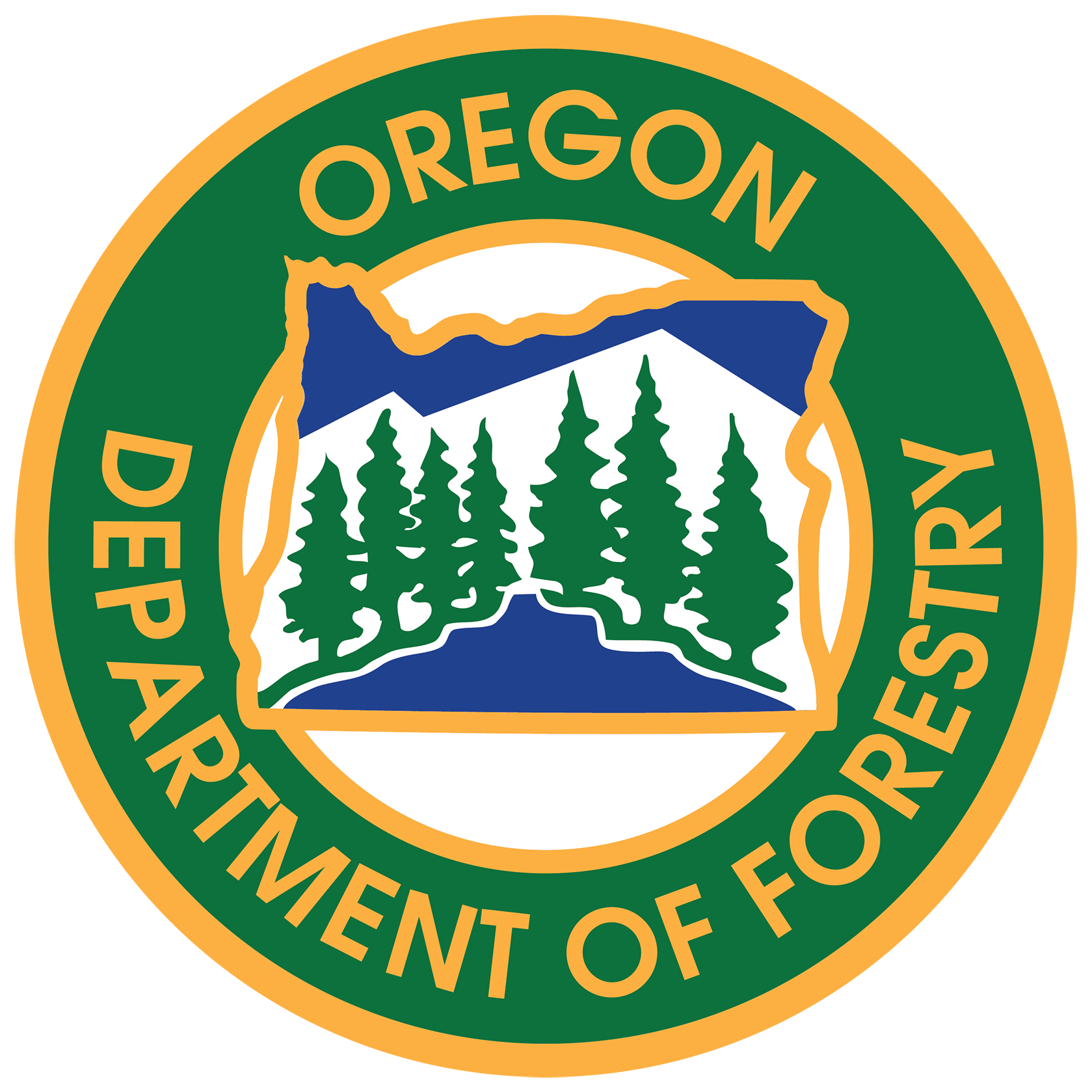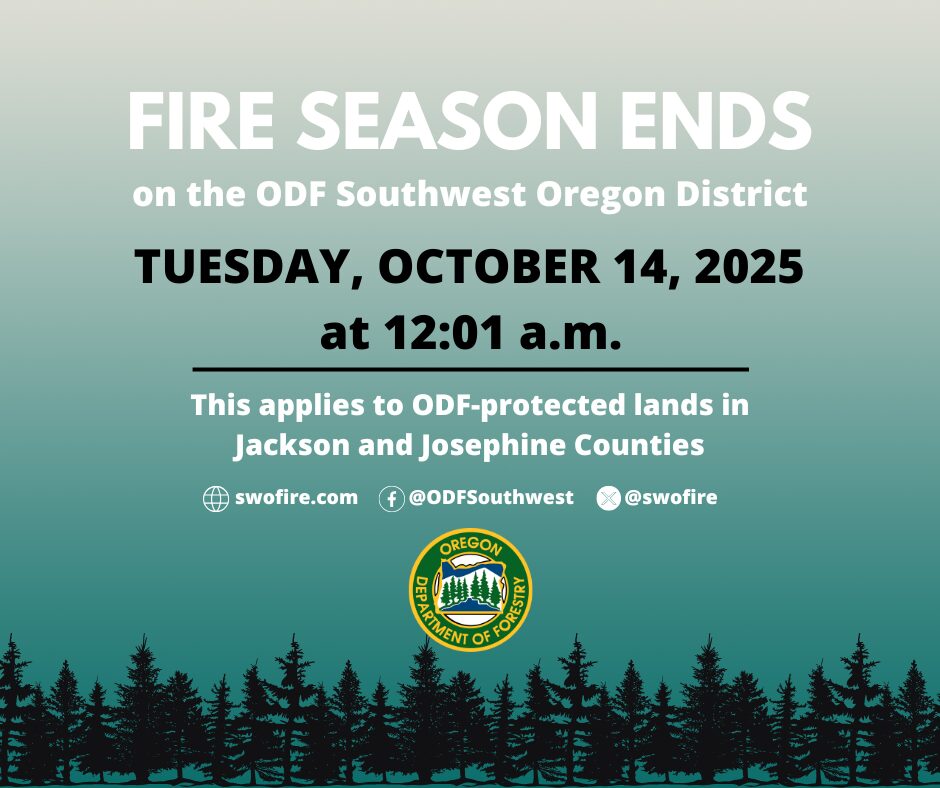JACKSON & JOSEPHINE COUNTIES, Ore. (Oct. 13, 2025) – After 135 days, the Oregon Department of Forestry (ODF) Southwest Oregon District is officially declaring an end to the 2025 fire season in Jackson and Josephine Counties, taking effect Tuesday, October 14, 2025 at 12:01 a.m. Multiple days of widespread rain across the district and a shift to consistent fall weather has allowed for all fire season regulations and Industrial Fire Precaution Levels (IFPL) to be lifted this week. This declaration affects 1.8 million acres protected by ODF across Jackson and Josephine counties. At this time, industrial slash burning still remains prohibited.
Since fire season was declared on June 1, ODF firefighters responded to 281 fires across Jackson and Josephine counties, totaling 3,558 acres affected. The first large fire of the season was the Upper Applegate Fire on June 18, located along the 2000-block of Upper Applegate Road. This fire occurred two days ahead of the anniversary of the 2024 Upper Applegate Fire. Both fires were located in the same general area, with similar weather and vegetation moisture levels, however this year’s fire started roughly three hours earlier in the day. Additionally, on both days, ODF was responding to a second fire during initial attack. While there are slight nuances to the data, these events are similar in nature across the board. Despite these similarities, fire managers attribute bringing ODF initial attack firefighters on earlier to the faster response, quicker containment and smaller acres achieved on this year’s incident.
Consistent thunderstorms throughout the season created numerous challenging weeks for the district, with the July 7 storm igniting nearly 40 fires across ODF-protected land in Jackson and Josephine counties at once. The Grizzly and Eastside Lightning Complexes were the result of this storm, totaling 22 and 17 fires respectively, and burning 1,060 acres total. The largest of these fires included the Neil Creek Road Fire along Interstate 5 south of Ashland caught at 257 acres, and the Deming Gulch Fire in the Applegate caught at 250 acres. ODF Incident Management Team 3 was ordered to relieve the district of some of these incidents, allowing local firefighters to extinguish the rest and return to a stronger state of readiness for initial attack on new fire starts, which occurred following additional thunderstorms. These 39 fires across the district were all fully extinguished within a month of their natural ignition.
In early September, thunderstorms produced numerous fires in the Lower Rogue River Corridor, an area of southern Oregon notorious for large fires due to the limited road access, extremely steep terrain and numerous hazards to responding firefighters. Twelve fires were started by the September 3 storm, with all but one immediately caught at two acres or less. The Kelsey Peak Fire created the largest number of challenges for firefighters and grew to over 100 acres in the following days due to hot, windy conditions, steep slopes and no road access. Weather conditions and terrain continued to fuel fire growth, and by the week’s end, the district ordered ODF Incident Management Team 1 to take command of the fire and allow local resources to return to their normal response readiness. The Kesely Peak Fire ultimately became the largest fire of the season on the district, caught at 1,039 acres in approximately three weeks. Additionally, the district was engaged on the Moon Complex six miles to the east during this time, providing resources for precautionary structure protection and contingency lines to the IMTs serving our partners at the U.S. Forest Service Rogue River-Siskiyou National Forest and the Bureau of Land Management Medford District.
Fall-like weather arrived in southern Oregon in early October, prompting decreases in fire danger levels and a shift toward the end of the season. With cooler weather and rain consistently in the forecast, the declared fire season is ending.
ODF has an annual goal of putting out 98% of fires at 10 acres or less. Despite numerous thunderstorms throughout the season igniting multiple lightning-caused fires at once, 258 fires were caught at this standard, nearly meeting this metric at 92%. The overall success on the district locally is largely due to a fast and aggressive response to fires and collaboration with our local and federal partners.
The largest fires of the season on the district are listed below:
| Fire Name | Date | Location | Acres | Cause | |
| Kelsey Peak Fire | Sept. 3 | 15 miles west of Glendale | 1,039 | Lightning | |
| Grizzly Lightning Complex | July 7 | Jackson and Josephine co. lightning fires | 887 | Lightning | |
| Upper Applegate Fire | June 18 | 2000-block of Upper Applegate Rd., Jackson County | 470 | Under Investigation | |
| Board Shanty Fire | July 17 | 2000-block of Board Shanty Rd., Josephine County | 469 | Under Investigation | |
| Eastside Lightning Complex | July 7 | Jackson County lightning fires | 173 | Lightning | |
| Hammel Road Fire | July 10 | Dodge Bridge County Park, Jackson County | 12.5 | Under Investigation | |
| E. Trail Creek Road Fire | July 1 | Highway 227 north of Trail | 11.5 | Lightning | |
| Colestin Fire | July 7 | One mile north of OR-CA border, Colestin | 10.5 | Under Investigation | |
The termination of fire season removes fire prevention regulations on equipment use and the use of fire for debris burning. This applies to the public and industrial operations on forestlands, however, industrial slash burning is still prohibited. Many structural fire agencies require permits for residential debris burning; please check with your local fire department to obtain any necessary permits before burning and ensure it’s a burn day designated by the county you reside in:
- Jackson County Burn Line: (541) 776-7007
- Josephine County Burn Line: (541) 476-9663
Even though the fire season is officially over, please continue to practice fire prevention when burning debris by ensuring a burn pile is never left unattended and using caution when using machinery that could cause a spark. While the heightened risk of fires has passed with the ending of the declared fire season, fires can still start and spread in fall and winter conditions. ODF firefighters will continue to be available to respond to fires throughout the year; partner with ODF and area fire agencies in fire prevention by following the debris burning guidelines put in place by your local fire department.
Fire prevention tips and information from the ODF Southwest Oregon District is available online at our Facebook page, @ODFSouthwest and our website, www.swofire.com.

